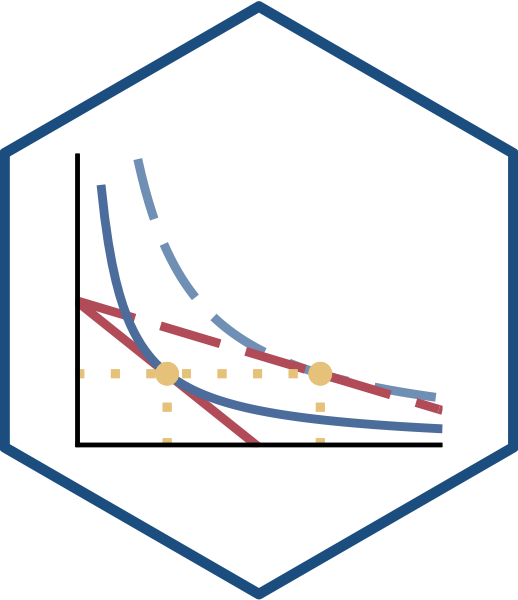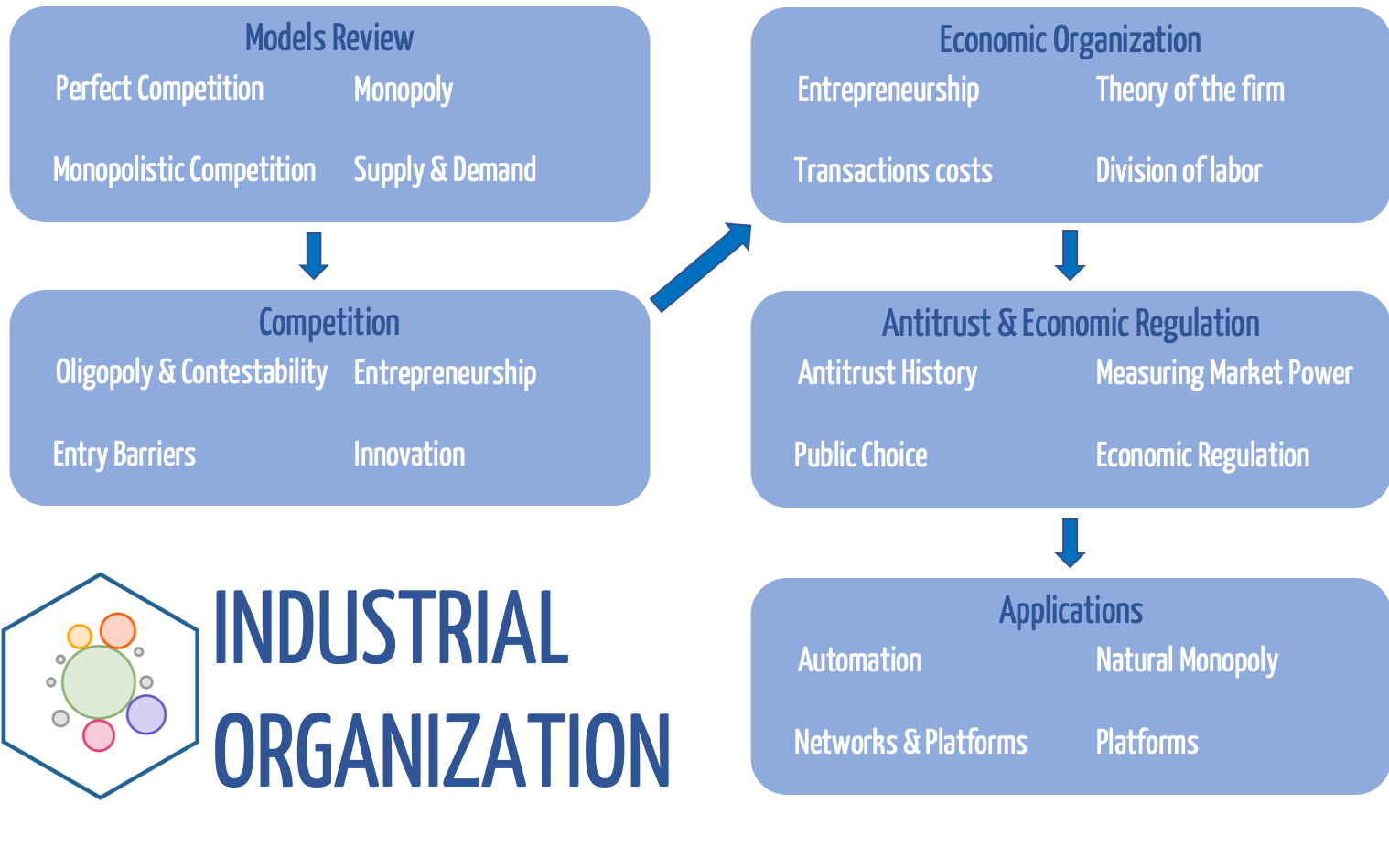1.1: Introduction to Industrial Organization
ECON 326 · Industrial Organization · Spring 2020
Ryan Safner
Assistant Professor of Economics
safner@hood.edu
ryansafner/IOs20
IOs20.classes.ryansafner.com
Industrial Organization
How are industries organized, and why do they operate the way they do?
How do we properly regulate industry?
How does, and should, actual competition between firms work?

You Already Know a lot of IO Basics

George Stigler
1911-1991
Economics Nobel 1982
"Let us start this...on a higher plane of candor than [we] will always maintain, there is no such subject as industrial organization," (p.1).
"These courses deal with the size, structure, the effects of concentration on competition, the effects of competition upon prices, investment, innovation, and so on. But this is precisely the content of economic theory - price or resource allocation theory, now often given the unfelicitious name of microeconomics," (p.1).
Stigler, George J, 1968, The Organization of Industry
You Already Know a lot of IO Basics
You (hopefully) learn(ed) in Microeconomics (206, 306):
Market structures:
- perfect competition
- monopoly
- monopolistic competition
- oligopoly

You Already Know a lot of IO Basics
You (hopefully) learn(ed) in Microeconomics (206, 306):
Something about the following concepts:
- pricing
- game theory
- antitrust
- entrepreneurship

Imperfect Competition

Imperfect Competition

Imperfect Competition

Imperfect Competition

Classic Elements of Industrial Organization
Structure-Conduct-Performance (SCP) paradigm
Price theory and Game theory
Economics of Organization/Firms
Antitrust and economics of regulation

Structure-Conduct-Performance Paradigm

- An industry's "Performance"
- Price (high, low)
- Output (high, low)
- Profit
- Productive efficiency
- Allocative efficiency (CS, DWL)
- Quality, safety, etc.
Structure-Conduct-Performance Paradigm

- ... which is determined by its firms' "Conduct"
- Pricing behavior
- Output choices
- Legal tactics
- Entry and exit
- Collusion
- Competition
- Innovation
Structure-Conduct-Performance Paradigm

- ... which is determined by the industry's "Structure"
- Number of buyers
- Number of sellers
- Product differentiation
- Vertical integration
- Barriers to entry
Structure-Conduct-Performance Paradigm

- ... which is determined by the product's "Technology"
- Consumer demand (price and income elasticity, substitutes, location, etc)
- Good's characteristics: inputs, technology, durability, rivalry, excludability
- Production features: economies of scale, economies of scope, network externalities, two-sided platforms
Structure-Conduct-Performance Paradigm

- Government policy can affect nearly every stage
- Entry regulation
- Price regulation
- Antitrust regulation
- Taxes and subsidies
Limitations of SCP
How do you define "an industry"
- What does Coca Cola compete with?
- What does Google compete with?
Substitutes in production vs. substitutes in consumption?
Geographic boundaries

Price Theory
Economics is a way of thinking based on a few core ideas:
People respond to incentives
- Money, punishment, taxes and subsidies, risk of injury, reputation, profits, sex, effort, morals
Environments adjust until they are in equilibrium
- People make adjustments until their choices are optimal given others’ actions


Price Theory: Optimization and Equilibrium
If people can learn and change their behavior, they will always switch to a higher-valued option
If there are no alternatives that are better, people are at an optimum
If everyone is at an optimum, the system is in equilibrium


The Major Models of Economics
Optimization
Agents have objectives they value
Agents face constraints
Make tradeoffs to maximize objectives within constraints

The Major Models of Economics
Optimization
Agents have objectives they value
Agents face constraints
Make tradeoffs to maximize objectives within constraints

Equilibrium
Agents compete with others over scarce resources
Agents adjust behaviors based on prices
Stable outcomes when adjustments stop

Economics (Price Theory) Is Broader Than You Think

Remember: All Models are Wrong!
Caution: Don't conflate models with reality!
Models help us understand reality.
A good economist is always aware of:
- "ceterus paribus"
- "...and then what?"
- "...compared to what?"

Economics IO Often Uses, but Is Not Limited to, Math

The Economics of Organization
Studying the problem of economic organization provides more perspectives
Firms (hierarchies) and markets are substitutable methods of production
Team production of many economic goods and services
Organize to minimize transaction costs in production

The Economics of Organization
Most production takes place in firms
Firms grapple with their own principle-agent problems:
- management vs. labor, management vs. owners
Firms must relate to other firms
- specialization & division of labor
- up/downstream market power
- mergers & acquisitions, vertical integration

Game Theory and Strategic Behavior
- Game theory: a set of tools that model strategic interactions ("games") between rational players, 3 elements:
- Players
- Strategies that players can choose from
- Payoffs are jointly-determined from combination of all players' strategies

Game Theory vs. Price Theory Models I
Optimization models ignore all other agents and just focus on how can you maximize your objective within your constraints
- Other agents are a primary cause of your constraints - but not considered in the model!
- Consumers max utility; firms max profit, etc.
Outcome: optimum: decision where you have no better alternatives

Game Theory vs. Price Theory Models II
Traditional economic models are often called Decision theory:
Equilibrium models assume that there are so many agents that no agent's decision can affect the outcome
- P.C.: firms are price-takers
- Monopoly: the only buyer or seller
- Ignores all other agents' choices!
Outcome: equilibrium: where nobody has no better alternatives

Game Theory vs. Price Theory Models III
Game theory models directly confront strategic interactions between players
- How each player would respond to a strategy chosen by other player(s)
- Lead to a stable outcome where everyone has considered and chosen their best responses
Outcome: Nash equilibrium: where nobody has a better strategy given the strategies everyone else is playing

Motivations for this Semester
Unequal Growth, or Unshared Prosperity? I
Common argument: "real wages have been stagnant since 1970" or "real wages have not kept up with productivity since 1970"
Labor's share of national income has gone down recently
Might this be because of increasing market power?

Unequal Growth, or Unshared Prosperity? II

Unequal Growth, or Unshared Prosperity? III

The Rise of Market Power?

Is New Antitrust Action Necessary?

Is New Antitrust Thinking Necessary?

Questions for the Semester
Has there been a general increase in market power/concentration?
If so, what should we do about it?
Should we revitalize antitrust laws?
How should we regulate platforms like Facebook, Amazon, Google, etc. uniquely problematic?
Other Proposals I Hope to Discuss
Is "property" another name for monopoly? Should we adopt a Common Ownership Self-Assessed Tax?
Should your data be owned (and compensated) as labor?
Will automation take all the jobs? If so, what do we do about that?

Other Proposals I Hope to Discuss

Unintended Consequences

About This Course
Learning Goals I
Understand key economic models of perfect competition, monopoly, monopolistic competition, oligopoly (Bertrand, Cournot, and Stackelberg competition), and contestable markets
Apply models of competition to different industries and regulatory regimes
Simulate strategic and game theoretic interactions and apply them to industry behavior
Discuss how firms actually compete with one another
Learning Goals II
- Critique textbook models and theories of regulation and antitrust
- Understand the economic problems that firms solve, create, and grapple with
- Debate regulatory solutions to problems and current events in various industries
Format For the Course
- Part lecture, part conversation
- Multiple lectures to introduce topic, give background and context
- Some readings-based discussions

A Hybrid Course in Three Parts
- Models/Review
- Production theory (technology, costs, etc)
- Market structures (perfect competition, monopoly)
- Some extensions beyond ECON 306
- Mostly lecture (1 or 2 discussions)
- Some math & practice (HWs, Midterm)
A Hybrid Course in Three Parts
- Competition
- Oligopoly models
- Game theory
- Playing games in class (Moblab)
- Applications & readings on how firms compete
- competitive process
- entrepreneurship
- innovation
- Mix of lecture and discussions
A Hybrid Course in Three Parts
- Applications
- Why firms exist & challenges for firms
- Antitrust (theory, history, applications)
- Regulating natural monopoly: telecom
- Automation, gig economy
- Networks, platforms, ownership of data
- More readings and discussions with some lecture
Assignments
| Assignment | Percent | |
|---|---|---|
| n | Participation (Average) | 20% |
| n | Homework (Average) | 10% |
| 1 | Position Paper | 25% |
| 1 | Midterm | 20% |
| 1 | Final (Take-home) | 25% |
See more details at the assignments page
Readings


Textbooks You Might Want


So We Can Play Games :)


Tips for Success, Or: How to College
Take notes. On paper. Really.
Read the readings. I've optimized them for you.
Participate*
You are learning how to learn
See the reference page for more

Roadmap for the Semester

